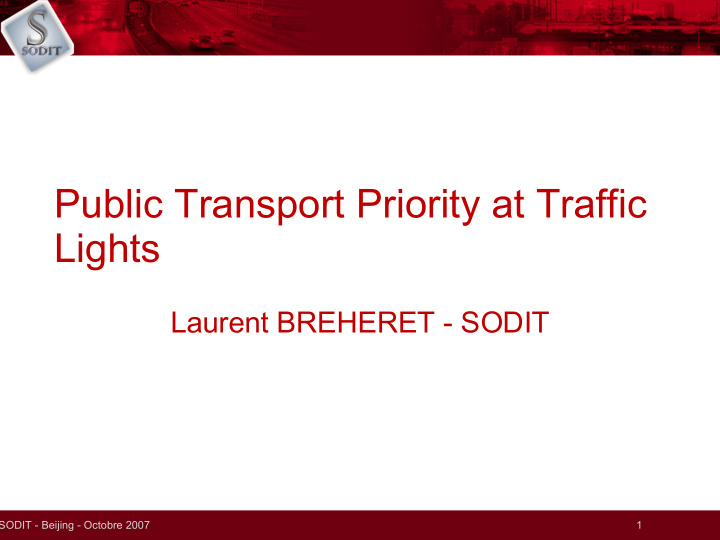



Public Transport Priority at Traffic Lights Laurent BREHERET - SODIT SODIT - Beijing - Octobre 2007 1
General concepts for PT priority A PT priority system aims at coordinating a set of actions, each of them favoring Public Transport while crossing junctions against all other users Two categories of actions have to be undertaken : Static Priority Dynamic Priority SODIT - Beijing - Octobre 2007 2
Static Priority Priority Vehicles are considered when traffic signal plan is calculated Signal Plan minimise their theoretical waiting time : green wave based on their usual speed Where to use it : Routes with high PT frequency Few variations of traffic SODIT - Beijing - Octobre 2007 3
Dynamic Priority On-line adaptation of the signal plan (microregulation) in order to favour PT Done by the traffic controler Well-suited when traffic conditions are changing rapidly, and when frequency of prioritary vehicles is low Two categories of actions: Earlier or longer compatible green phase Insertion of a green phase dedicated to PT SODIT - Beijing - Octobre 2007 4
Impact of PT Priority on traffic PT frequency, traffic volumes and design and capacity of junctions have a great impact on priority efficiency/performance Generally, the higher benefits for the PT, the greater degradation for other road users The computation of signal plans and determination of activation rules are of the greatest importance SODIT - Beijing - Octobre 2007 5
Efficient approach for PV Specific road design can improve the approach of priority vehicles to the junction Reduce absolute value of arrival time Reduce incertainty on arrival time Road installation Reserved lane, full or only near the junction Commercial stop after the junction Separated road SODIT - Beijing - Octobre 2007 6
Components of the priority system Detecting the vehicle Local detection On-board localisation Transmission of this information to the traffic light controller Management of the priority demand Local decision Centralised decision 4 system architectures are possible SODIT - Beijing - Octobre 2007 7
Local detection / local decision Traffic controller receives the approach info And compute the new signal plan on its own SODIT - Beijing - Octobre 2007 8
Local detection / Centralised decision PV approach detected by traffic controller Adapted signal plan computed by a control centre Traffic controller receives new decision from CC SODIT - Beijing - Octobre 2007 9
On-board localisation / Local decision The vehicle is localised by a control centre The traffic controller manages locally the priority demand SODIT - Beijing - Octobre 2007 10
On-board localisation / Central decision The vehicle is localised by a control centre Which transmits the info to a Traffic Control Centre The TCC sends priority orders to the local controller SODIT - Beijing - Octobre 2007 11
Comparaison des Architectures ACTION LOCALE ACTION CENTRALISEE Connexion à un PC-Trafic pas nécessaire Contrôleur de carrefour à feux remonte les informations et obéit aux ordres du PC Circulation Avantages : Détection Locale - Robustesse du Système Avantages : - Précision de la détection - Maîtrise de l’impact de la priorité des TC sur Fiabilité de la chaîne d’information l’écoulement des VP - Inconvénients : Inconvénients : - Paramétrage du Système - Repose sur l’architecture de communication du PC - Système peut évolutif Circulation Domaines d’emploi privilégiés : - Repose sur les performances du PC Circulation - TCSP Domaines d’emploi privilégiés : Carrefours isolés - Maîtrise de la priorité des TC par le PC Circulation - Dialogue TC Contrôleur de carrefour à feux Dialogue PC SAE PC Circulation Localisation embarquée Connexion à un PC-Trafic pas nécessaire Avantages : Avantages : - TC utilisés comme capteurs par le PC circulation - Suivi précis de la progression du TC dans la circulation Inconvénients : - Système paramétrable à souhait - Repose sur l’architecture de communication du PC SAE - Système évolutif ainsi que du PC Circulation Inconvénients : - Repose sur les performances du PC Circulation - Localisation précise des TC nécessaire Domaine d’emploi privilégié : - Fiabilité de la chaîne d’information - Gestion globale des déplacements : information TC Domaine d’emploi privilégié : utilisé pour la régulation du trafic, réglage des feux - Bus évoluant dans la circulation générale adaptés au modifications d’itinéraires SODIT - Beijing - Octobre 2007 12
PT priority in 5 steps SODIT - Beijing - Octobre 2007 13
Programming of data exchanges Influence Zone of the controller Zone d'influence du contrôleur Point d'arrêt Point d'appel n°1 n°2 n°3 Acquittement Several approach Curves Trafic fluide - Pas d’arrêt Temps Courbe théorique Trafic dense – Avec Arrêt Distance SODIT - Beijing - Octobre 2007 14
Basic Equipments Vehicle Communication positioning Vehicle to infrastructure Priority Communication PC Circulation PC SAE TCRA management at of receiver at the Ville d’Avignon the traffic light controller GPS Position Heure Point Haut Demande de Priority priorité demand Début de zone Fin de zone Beginning of the End of the influence zone influence zone prioritaire prioritaire SODIT - Beijing - Octobre 2007 15
Thank you for your attention Laurent Breheret SODIT – France breheret@sodit.info SODIT - Beijing - Octobre 2007 16
Recommend
More recommend